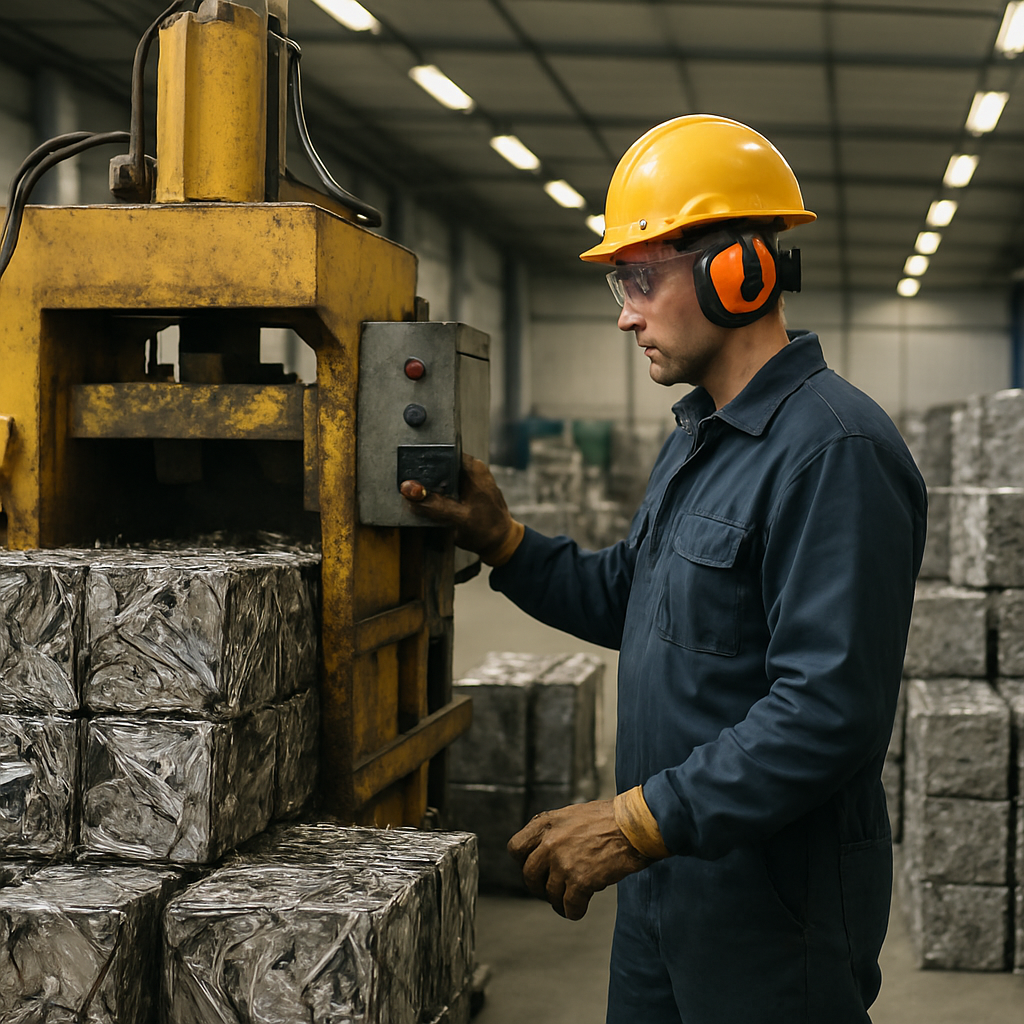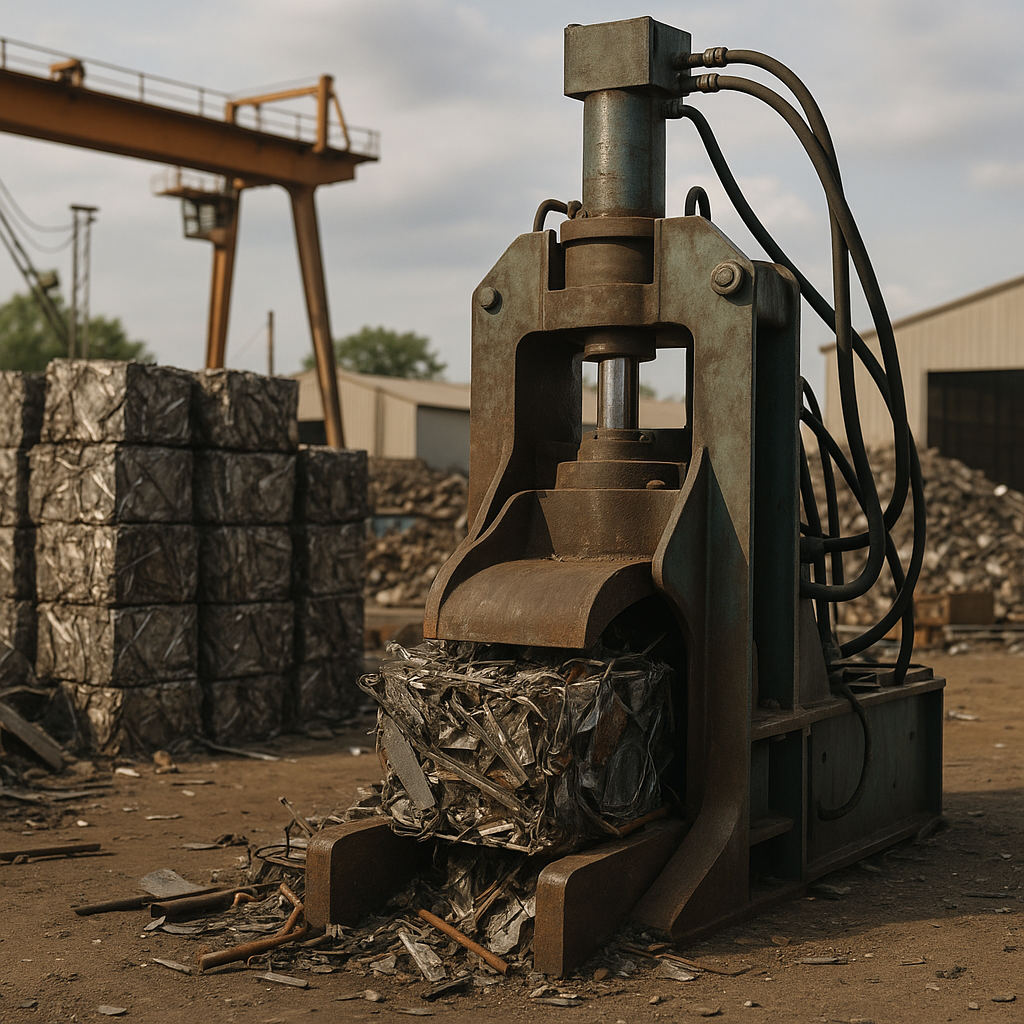5901 Botham Jean Blvd, Dallas, TX 75215
Scrap Metal Densification Process: Benefits, Machinery Types, and Recycling Efficiency
October 7, 2025Every day, recycling facilities worldwide face a common challenge: mountains of loose, bulky scrap metal taking up valuable space. The solution is scrap metal densification. This process compresses loose metal materials into compact, high-density forms, changing the way we handle, store, and transport recyclable metals.
At its core, scrap metal densification involves applying tremendous pressure to transform scattered metal waste into uniform, dense packages. Using specialized hydraulic machinery capable of exerting thousands of pounds of pressure per square inch, recyclers compress metal scrap into manageable bricks, tubes, or blocks. The transformation is remarkable—what once filled an entire truck bed might now occupy just a small fraction of that space.
This volume reduction technique is a crucial link in the metal recycling chain. By significantly decreasing the physical footprint of scrap metal—sometimes achieving compression ratios as high as 50:1—densification offers practical and economic advantages for recycling operations of all sizes. The resulting dense materials are not only easier to stack and store but can also be efficiently loaded onto conveyor systems or transportation vehicles, streamlining the entire recycling workflow.
What Are the Benefits of Scrap Metal Densification?

Scrap metal densification transforms loose, bulky metal waste into compact, uniform blocks. This process delivers substantial benefits for recycling operations, manufacturing facilities, and the environment, offering financial, safety, and sustainability improvements beyond simple space saving.
Volume Reduction and Space Optimization
The most immediate benefit of densification is dramatic volume reduction. The process can compress scrap metal at ratios of up to 50:1, converting large piles of loose scrap into manageable, uniform blocks. This transformation significantly reduces storage requirements.
Facilities implementing densification systems can store substantially more material in the same footprint, an efficient use of space particularly valuable in urban areas where real estate costs are high. Companies can maintain higher inventory levels without expanding their physical facilities.
The compact nature of densified scrap also enables more organized storage practices. Unlike loose scrap that creates irregular piles, densified blocks can be stacked systematically, improving inventory management and accessibility.
Transportation Cost Reductions
Transportation expenses represent a substantial portion of recycling operational costs. Densification addresses this directly by allowing more metal to be shipped per truckload. When scrap is compressed, carriers can reach maximum weight limits without wasting space.
The financial impact is considerable. A single truck can transport up to five times more densified scrap than loose materials. This efficiency reduces the number of required shipments, cutting fuel consumption, driver hours, and vehicle maintenance costs.
These savings extend throughout the supply chain. From collection points to processing facilities and finally to end manufacturers, each transportation leg becomes more cost-effective when handling densified materials.
Enhanced Market Value
Densified scrap consistently commands higher market prices compared to loose materials. This price premium stems from qualities that make densified scrap more valuable to processors and mills.
First, densified materials have a uniform shape and consistent density, making them easier to handle and process. Second, the compression process often helps contain contamination, resulting in cleaner material with less non-metallic content. Finally, the predictable form factor simplifies quality assessment and valuation.
Mills and foundries prefer densified scrap because it melts more efficiently in furnaces and creates less slag. This processing advantage translates into higher offered prices. Recyclers report price premiums of 10-15% for properly densified materials compared to loose equivalents.
Improved Workplace Safety
Safety considerations represent another compelling reason to densify scrap metal. Loose scrap presents numerous hazards, including sharp edges, unstable piles, and awkward handling requirements.
Densification addresses these risks by containing sharp edges within compressed blocks. The uniform shape creates stable, stackable forms that reduce tipping and falling hazards. Workers handle fewer individual pieces, decreasing cut and puncture injuries.
The process also minimizes dust and small particle generation, reducing respiratory risks and creating cleaner work environments. These safety improvements can lead to fewer workplace incidents, lower insurance premiums, and better regulatory compliance.
Operational Efficiency and Processing Advantages
Recycling facilities gain significant operational benefits from processing densified materials. The uniform blocks streamline handling throughout the facility, requiring fewer equipment adjustments and operator interventions.
Loading furnaces becomes more consistent with standardized blocks, improving melt schedules and energy efficiency. The reduced volume means less material handling equipment is needed, and existing systems experience less wear and maintenance requirements.
Densification also enhances quality control processes. The compression reveals material inconsistencies and helps identify contamination that might otherwise remain hidden in loose piles. This early detection prevents downstream processing problems.
Environmental Sustainability Benefits
The environmental advantages of scrap metal densification align with broader sustainability goals. Reduced transportation requirements directly decrease carbon emissions from fewer truck movements. Studies indicate up to a 75% reduction in transport-related emissions when shipping densified versus loose scrap.
Energy consumption throughout the recycling chain decreases with densified materials. The more efficient melting process uses less energy per ton of processed metal, translating into a smaller carbon footprint for recycled metal products.
Additionally, densification supports higher recycling rates by making collection and processing more economical. When recyclers can handle more volume efficiently, they can expand collection programs and divert more metal from landfills.
The overall environmental impact is substantial. Recycling aluminum through densification processes saves 95% of the energy required to produce new aluminum from raw ore. Steel recycling through similar methods saves about 75% of energy requirements.
Scrap metal densification creates a powerful combination of economic and environmental advantages. The process transforms challenging materials into valuable, efficient resources. For recycling operations looking to improve profitability while enhancing sustainability practices, densification technology represents an important strategic investment.
What Types of Scrap Metal Densification Systems Are Available?

Stationary Balers
Stationary balers serve as the backbone of high-volume recycling operations. These permanently installed systems seamlessly integrate with conveyor systems, shredders, and other processing equipment for efficient recycling lines.
These robust machines feature reinforced steel construction to withstand the demands of continuous operation. Their fixed position allows for greater processing capacity than portable options, making them ideal for facilities with consistent material streams.
Many recycling centers choose stationary balers for their ability to efficiently handle large volumes. Their substantial throughput capabilities make them cost-effective for operations processing significant quantities of scrap daily.
Portable Balers and Compactors
Portable densification systems bring recycling capabilities directly to the source of scrap generation. These mobile units can be transported to construction sites, demolition projects, and temporary collection points.
Mounted on trailers or skid frames, portable balers eliminate transportation costs for loose scrap. They produce compact bales that maximize shipping efficiency while offering flexibility for contractors and remote operations.
These systems typically sacrifice some capacity for mobility but provide significant advantages for operations that generate scrap at multiple locations or need temporary processing capabilities.
Lid-Style Balers
Lid-style balers excel at processing larger scrap metal pieces. Their top-loading design features a hydraulic lid that closes over the chamber for initial compression.
This configuration works effectively with bulky materials like automobile parts and sheet metal. The lid applies downward force while the main ram provides horizontal compression, creating dense, uniform bales from materials that might overwhelm standard systems.
Recyclers handling oversized scrap often prefer lid-style balers for their ability to manage awkward shapes. The dual-direction compression effectively handles materials that resist standard baling methods.
Hopper-Type Balers
Hopper-type balers are specifically engineered for lightweight metals such as aluminum cans, small components, and thin gauge materials. These systems feature large feeding hoppers that allow continuous loading without frequent shutdowns.
Their design ensures efficient operation for high-volume, low-density materials commonly processed in beverage recycling operations. The continuous feed capability increases throughput for materials that would otherwise require multiple loading cycles.
Manufacturing facilities generating consistent streams of lightweight scrap benefit from these specialized systems. The hopper design is ideal for production environments with steady material flows.
Advanced Densification Technology
Fully automatic balers represent the forefront of recycling technology, handling the entire process with minimal operator intervention, from material loading to bale ejection.
Although they require a higher initial investment, automatic balers significantly reduce labor expenses and maximize productivity. Their continuous operation capability is valuable for facilities processing large volumes consistently.
Double-plunger balers utilize two hydraulic rams operating at different angles to create more uniform compression. This design achieves denser bales by applying pressure from multiple directions, particularly useful for materials that resist standard compression methods.
These advanced systems create more stable bales that maintain their shape during transportation. Materials that typically spring back after compression remain densely packed, optimizing shipping and storage efficiency.
Industry-Specific Solutions
Some densification systems are tailored to specific industrial applications. Shear/baler combinations incorporate cutting mechanisms that process oversized materials before baling, offering versatility for scrapyards that receive varied material sizes.
Heavy-duty balers incorporate reinforced components and powerful hydraulic systems designed for tough industrial scrap. These machines typically feature thicker steel walls, enhanced cylinder capacity, and specialized wear plates to withstand demanding materials.
Briquetting systems offer another specialized option, particularly for metal chips and turnings. These machines compress loose material into small, dense pucks that maximize melting efficiency and minimize slag formation during smelting.
| System Type | Key Features | Applications |
| Stationary Balers | High processing capacity, reinforced steel construction, seamless integration with recycling lines | High-volume recycling facilities |
| Portable Balers and Compactors | Mobile, flexibility for onsite processing | Construction sites, demolition projects |
| Lid-Style Balers | Top-loading design, dual-direction compression | Bulky materials like automobile parts |
| Hopper-Type Balers | Large feeding hoppers, continuous loading | Lightweight metals like aluminum cans |
| Advanced Densification Technology | Fully automatic operation, double-plunger design | Facilities processing large volumes of materials |
| Industry-Specific Solutions | Custom features like shear/baler combinations, reinforced components | Scrapyards, industrial scrap processing |
The selection of the appropriate densification system ultimately depends on several key factors. Material type, desired output form, processing volume, available space, and industry requirements all influence which system will deliver optimal results for specific recycling operations.
Conclusion: The Future of Scrap Metal Densification
The scrap metal densification process is leading the way in modern recycling innovation. As environmental challenges grow, these technologies offer effective solutions for maximizing resource efficiency and minimizing waste. The future of metal densification will likely be influenced by AI-powered sorting, robotics, and advanced analytics that enhance compression ratios and material recovery rates. These intelligent recycling systems will transform waste into valuable resources with minimal energy consumption.
The economic and environmental benefits of densification will continue to grow as technology advances. By reducing transportation costs, improving material recovery, and decreasing energy usage, densification offers advantages for both business operations and environmental sustainability. For your metal recycling needs, contact Okon Recycling at 214-717-4083.
